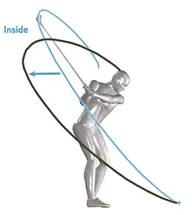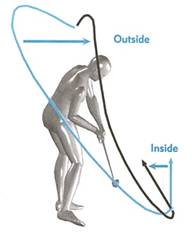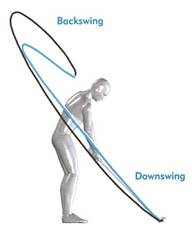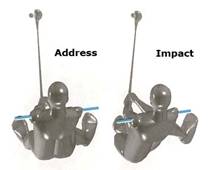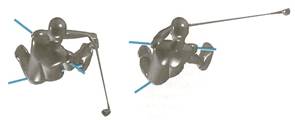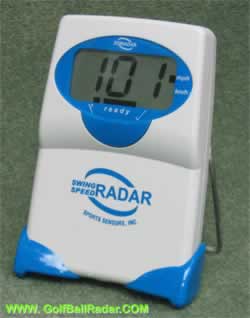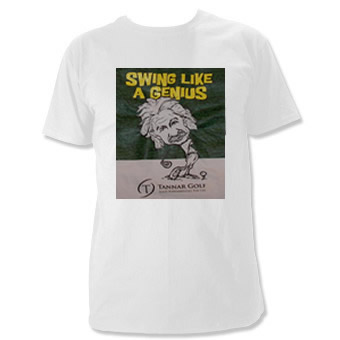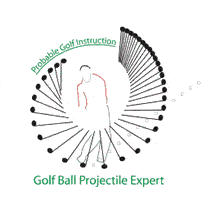
|
|
|
Downswing --Maintain Angles During Transition
From the top of the backswing, the downswing is initiated by the lower body with a rotation of the hips and gradual shifting of the weight to the front leg. In fact, with many good players, this lower body rotation begins even before the club reaches its highest position in the backswing. Thus, it's important that the transition between backswing and downswing occur slowly, and only with the lower body, not the arms and hands. In fact, the transition should take about 20% of the entire time from takeaway to impact. The downswing is led by the large muscles of the legs and the mid-section (abdomen). These muscles, although much stronger than the arms/hands, move more slowly and thus require more time to react. As the legs initiate the downswing, the forward foot begins to plant itself firmly on the ground. Try the Step Drill: http://www.youtube.com/watch?v=8jCX-8s6_XU
It's this slow transition phase (from backswing to downswing) which enables the golfer to maintain the angles set in the backswing. Note Tiger's angles at the top of his backswing. There is about an 80 degree angle between the arms and the club and about a 30 degree agnled between the arms and the shoulders. Halfway down in his downswing, he's maintained all of the angle between the club and arms. The angle between the shoulders and arms has grown only slghtly.This is acheived through the arms and hands being relaxed and passive (just enough tension to hang on to the club). Most amateurs start the swing with the hands and arms and lose their angles during the first half of the downswing.
Take a look at this slow motion video of Tiger hitting an iron at the 2007 PGA. I grabbed a stopwatch and timed the various parts of the swing. In slow motion (thus time measured will be much longer than real time), here are the times for Tiger: From takeaway to impact = 21.4 Transition Period = 6.6 I measured the transition period to be from when Tiger's hands are level with his head from backswing to downswing. The ratio of his transition period to total (backswing-forwardswing) is 6.6 to 21.4 which is about 30%. He spends almost 1/3 of the time changing direction at the top of the swing. Likewise, take a look at Tom Watson's swing. From takeaway to impact = 9.7 Transition Period = 3.5 Note that the times for Watson's are shorter due to the slow motion video being at a different rate. The ratio of his transition period to total is 3.5 to 9.7 which is about 36%, again measuring his hands from level with his head.
Have you ever heard the tip "wait for the club at the top of the swing"? This tip is referring to taking enough time during the transition period to change the direction of the club. You must do so slowly, so that the large muscles of the body have time to lead the downswing. Ideally, the club travels along approximately the same plane on the way down as on the up. A number of very good golfers actually have a slightly flatter downswing plane. They achieve this through a strong lower body rotation which drops the arms and club down.
On the other hand, many amateur golfers initiate the downswing with the arms and upper body, which moves the arms and club more outwards, creating and outside-to-inside swing path.
This move also puts the club in a position from which it is hard to release (close the club face), thus the face is left open. The result is a slice. Review your weight transfer lesson here: Golf Swing Weight Transfer -- The Athletic Move If one initiates the downswing well with a strong lower body rotation, the club will follow a swing plane very close to the backswing swing plane. The club path will be from inside the target line to along the target line to inside the target line.
The body should be in positioned similarly to the way it was at address except that:
• The hips are open, facing partially towards the target. • Most of the weight is on the front leg and on the middle to outside of the front foot. • The forward knee will flexed towards the target. • The hands are farther ahead of the ball.
Go to this page to learn a method of aligning using an intermediate target. CLICK HERE To learn more about Intermediate Focus Golf, CLICK HERE
Want to view other lessons in this series thus far. Click on the link below. Lesson #1: Golf Grip -- The Connection Lesson #2: Golf Stance & Set-up -- The Foundation Lesson #3: Golf Swing Plane -- The Swing Slot Lesson #4: Golf Swing Weight Transfer -- The Athletic Move Lesson #5: Golf Swing BackSwing -- The Takeaway & Coil Lesson #6: Golf Swing DownSwing -- Maintain Angles & Transition Period
©Probable Golf Instruction, Ken Tannar 2001-2015. All Rights Reserved. Langley, B.C. V2Y 2G4 CanadaPhone: 604-309-7030 FAX: to fax, email an attachment probablegolf@yahoo.ca or golfexpert@probablegolfinstruction.com |
| GOLF ASSISTANTS |
|
Golf Trip Pairing CalculatorPlanning a golf trip with some friends/family? Trying to sort out the foursomes so people don't play too often with others? Order your ready made Spreadsheet. Type in the names, print out the groupings. Minimize repeat pairings.
Wind Caddy will advise you on aim, distance and club so that you can play the wind successfully. It takes the guess work out of club selection. New option to enter custom distances for each club. The algorithm will make a club suggestion accordingly. Use the right club in every condition!
|
|
|
| GOLF NEWS |
Golf Putting Green Reading Glasses |
| GOLF NEWSLETTER |
Statistics
·Putting
·Longest Golf Balls
·Games
·Handicap
·Scoring
·Shot Patterns
·Tournaments
·PGA Tour Stats
Pro Shop
·Ball Marker Engraved
·Books
·CDs & DVDs
·Green Reader
·Impact Labels
·Laser Rangefinder
·Longer Drives
·Products
·Teaching Aids
|
|
| GOLF POLL |
The 19th Hole
·Advertising
·Ask the Golf Expert
·Consultation/Litigation
·FAQs
·Golf Blog
·Golf Draws
·Links
·Science of Golf
·Tell a Friend
·Testimonials
·

Golf Ball Finder Glasses
Find all your errant golf balls and many more!
| GOLF TIPS |
How to play:
|





